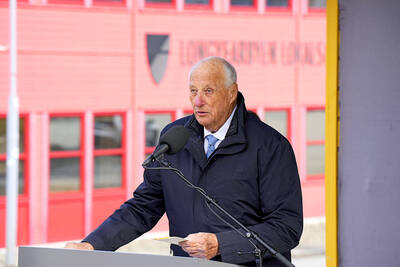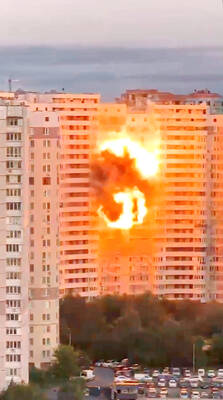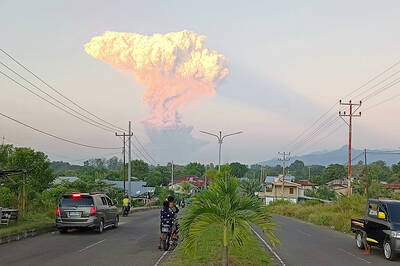A sleek piece of Cold War history was put on display at the CIA yesterday -- the once supersecret A-12 spy plane, which flew higher and faster than any other manned aircraft to spy on North Vietnam and North Korea.
"It was a beautiful airplane," said Ken Collins, a retired air force colonel and one of only six pilots to fly the A-12s.
Collins and other veterans gathered at CIA headquarters to reminisce about aircraft which shattered records for speed and altitude in the secrecy of a 1960s CIA program codenamed Oxcart.
A black, needle-nosed missile of a plane with curved wings that anticipated modern stealth aircraft, the A-12 hit speeds of more than 2,200mph (3,540kph), or more than 3.2 times the speed of sound.
It cruised at altitudes between 80,000 feet (24,400m) and 90,000 feet, so high that the earth's curvature was visible from its cockpit.
"A marvel of aeronautical engineering, the A-12 literally took people's breath away when they first saw it fly," said CIA director Michael Hayden, an air force general.
The aircraft was so fast that it took only about 12 minutes to traverse North Vietnam.
Temperatures on the edge of the cockpit windshield would rise to as high as 680?F (360?C), Collins said.
And as the plane blasted through Mach 2.5, two-and-a-half times the speed of sound, it would be slammed by shock waves so violent that the planes would pitch and yaw, and sometimes stall.
But Collins, who flew six missions over North Vietnam, told reporters "it was a beautiful airplane to land, and just technically a fantastic airplane to fly."
The A-12 on display on the grounds of the CIA -- which was known as "Article 128" -- is one 15 A-12s built. Only nine survive. Five were lost to crashes, and two pilots were killed.
Collins recalled ejecting and parachuting from an A-12 over Utah when a computer failure caused his aircraft to stall, pitch and go "flat upside down."
The A-12 was designed by Lockheed at its famous Skunk Works facility as a successor to the U-2, which had become increasingly vulnerable to Soviet air defense missiles.
"The goal was an aircraft that could outrun any Soviet missile," Hayden said.
They began operations in 1965, but flew combat missions out of Kadena Air Base in Okinawa for only two years before they were retired in 1968.
Ironically, the U-2 is still flying over Iraq and Afghanistan, though even it is now being eclipsed by high-flying drones called Global Hawks.
No A-12s were shot down, even though the Soviet Union learned of the outlines of the program and Russian and Chinese radars were able to track it.
"We were fired at frequently. They could track us. People kept changing our defense systems. But they kept coming up with new stuff," Collins said.
"But they never got the SAM [surface-to-air missiles] high and fast enough to get us. [We were] pretty comfortable up at 85,000 feet at 2,200 miles an hour," he said.
The CIA did not acknowledge the program's existence until 20 years after its last mission, and only this week declassified documents related to the program and published an official history of Oxcart.
Codenamed "Black Shield," the A-12s last missions were flown in 1968 over North Korea after the capture of the USS Pueblo, a US electronic surveillance vessel seized in international waters.
Hayden credited the photographs taken by the A-12s with two key intelligence findings.
Missions in 1967 found that North Vietnam had no surface-to-surface missiles, easing US fears of an escalation.
And an A-12 photographed the USS Pueblo in a North Korean port three days after it was seized on Jan. 23, 1968.

Former Nicaraguan president Violeta Chamorro, who brought peace to Nicaragua after years of war and was the first woman elected president in the Americas, died on Saturday at the age of 95, her family said. Chamorro, who ruled the poor Central American country from 1990 to 1997, “died in peace, surrounded by the affection and love of her children,” said a statement issued by her four children. As president, Chamorro ended a civil war that had raged for much of the 1980s as US-backed rebels known as the “Contras” fought the leftist Sandinista government. That conflict made Nicaragua one of

COMPETITION: The US and Russia make up about 90 percent of the world stockpile and are adding new versions, while China’s nuclear force is steadily rising, SIPRI said Most of the world’s nuclear-armed states continued to modernize their arsenals last year, setting the stage for a new nuclear arms race, the Stockholm International Peace Research Institute (SIPRI) said yesterday. Nuclear powers including the US and Russia — which account for about 90 percent of the world’s stockpile — had spent time last year “upgrading existing weapons and adding newer versions,” researchers said. Since the end of the Cold War, old warheads have generally been dismantled quicker than new ones have been deployed, resulting in a decrease in the overall number of warheads. However, SIPRI said that the trend was likely

BOMBARDMENT: Moscow sent more than 440 drones and 32 missiles, Volodymyr Zelenskiy said, in ‘one of the most terrifying strikes’ on the capital in recent months A nighttime Russian missile and drone bombardment of Ukraine killed at least 15 people and injured 116 while they slept in their homes, local officials said yesterday, with the main barrage centering on the capital, Kyiv. Kyiv City Military Administration head Tymur Tkachenko said 14 people were killed and 99 were injured as explosions echoed across the city for hours during the night. The bombardment demolished a nine-story residential building, destroying dozens of apartments. Emergency workers were at the scene to rescue people from under the rubble. Russia flung more than 440 drones and 32 missiles at Ukraine, Ukrainian President Volodymyr Zelenskiy

Indonesia’s Mount Lewotobi Laki-Laki yesterday erupted again with giant ash and smoke plumes after forcing evacuations of villages and flight cancelations, including to and from the resort island of Bali. Several eruptions sent ash up to 5km into the sky on Tuesday evening to yesterday afternoon. An eruption on Tuesday afternoon sent thick, gray clouds 10km into the sky that expanded into a mushroom-shaped ash cloud visible as much as 150km kilometers away. The eruption alert was raised on Tuesday to the highest level and the danger zone where people are recommended to leave was expanded to 8km from the crater. Officers also